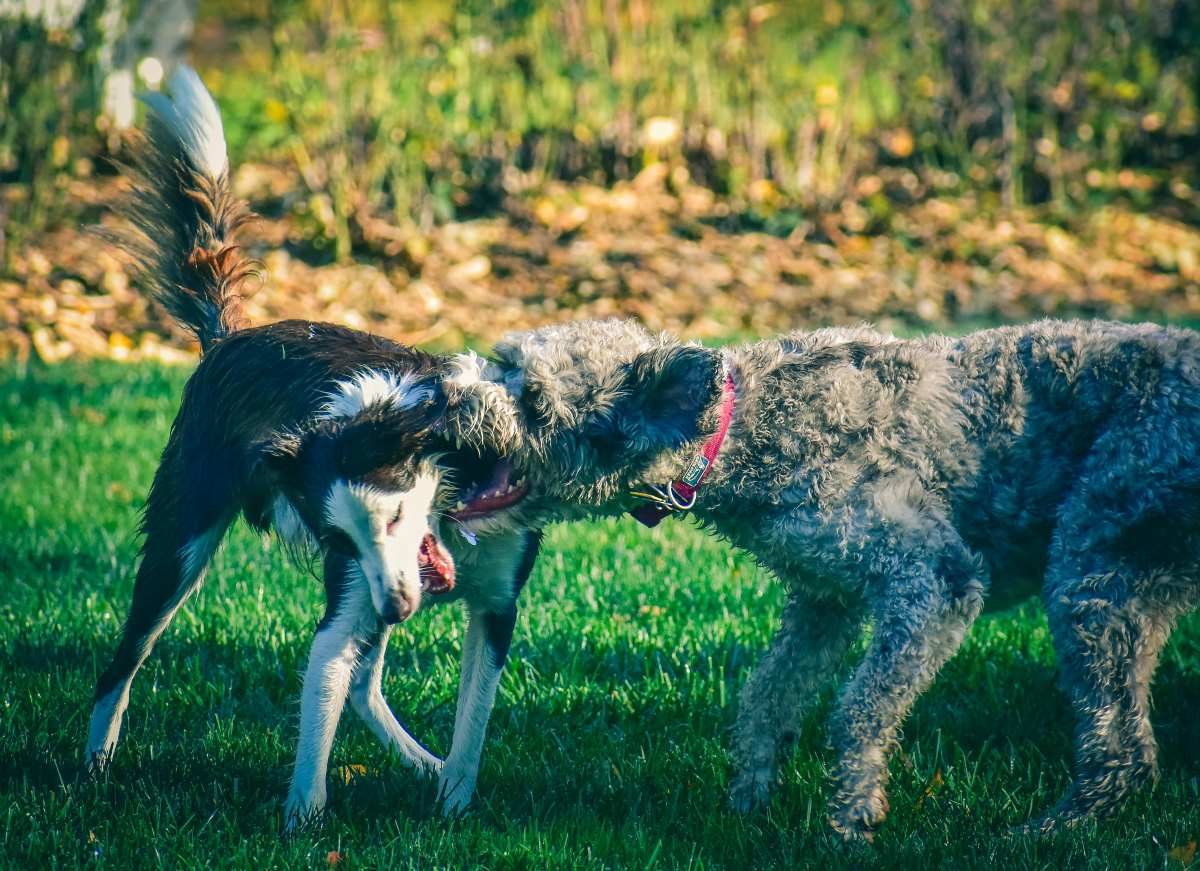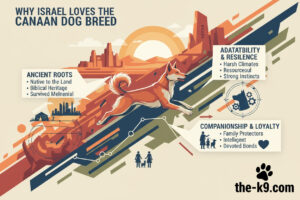
Learn to Calm Dog on Dog Aggression. Is your furry companion displaying aggressive behavior towards other dogs? Dog-on-dog aggression can be challenging to handle, but understanding the root causes and implementing effective strategies can help create a harmonious environment for both your pet and yourself.
Key Takeaways: Learn to Calm Dog on Dog Aggression
- Understanding the reasons behind dog aggression is crucial for finding the right solutions.
- Recognizing the signs of aggression early on can help prevent incidents.
- Evaluating the severity of aggression is essential in developing an appropriate training plan.
- Seeking the guidance of a professional trainer can greatly improve your chances of success.
- Implementing behavior modification techniques and managing interactions properly can bring positive change.
- Using Anxiety Treats like Hemp Dog Calming Chews
- Understanding Aggressive Behaviour in Dogs
- Recognizing the Signs of Aggression
- Assessing the Severity of Aggression
- Working with Professional Trainers to Calm Dog on Dog Aggression
- Behavior Modification Techniques
- Managing Aggression During Interactions
- Understanding Aggressive Dog Breeds
- Conclusion: Learn to Calm Dog on Dog Aggression
Understanding Aggressive Behaviour in Dogs
Before diving into solutions, it’s essential to understand why dogs may display aggressive behavior towards their canine counterparts. Aggression in dogs can stem from various triggers, such as fear, territoriality, and resource guarding. By recognizing and addressing these underlying causes, we can effectively manage and modify their behavior.
Common Triggers for Dog on Dog Aggression
Let’s take a closer look at the common triggers that can lead to canine aggression:
- Fear: A fearful dog may exhibit aggressive behavior as a defense mechanism. They perceive a threat and react accordingly, seeking to protect themselves.
- Territoriality: Dogs have a strong instinct to protect their territory. When they perceive another dog as a threat to their space or resources, they may display aggressive behavior.
- Resource Guarding: Some dogs become possessive over valuable resources, such as food, toys, or even their owners. This can lead to aggressive behavior when they feel their possessions are being threatened.
Understanding these triggers and their role in your dog’s aggression can help you tailor a targeted behavior modification plan to address their specific needs.
| Triggers | Description |
|---|---|
| Fear | A fearful dog may display aggression as a defense mechanism when feeling threatened. |
| Territoriality | Dogs may become aggressive when protecting their territory from perceived intruders. |
| Resource Guarding | Dogs may exhibit aggression to protect valuable resources, such as food, toys, or their owners. |
By addressing the root causes of aggressive behavior in dogs, we can implement effective strategies to mitigate and manage their aggression, creating a harmonious environment for everyone involved.
Recognizing the Signs of Aggression
Early intervention is crucial in addressing aggressive dog behavior to ensure the safety and well-being of all involved. By learning to recognize the signs of aggression, you can take proactive steps to manage and modify your dog’s behavior. Dogs communicate their aggression through various body language cues and vocalizations. Understanding these signals is essential for effectively addressing and diffusing aggressive episodes. Here are some common signs to look out for:
- Bared teeth: When a dog exposes its teeth and gums, it is a clear sign of aggression.
- Growling: Dog growls are often accompanied by raised hackles and a stiff posture, indicating aggression.
- Snarling: Snarling is a more intense display of aggression, where a dog shows its teeth and emits a low, guttural growl.
- Snapping: Dogs may snap at individuals or other dogs as an aggressive warning.
- Intense staring: A fixed gaze, with a direct stare and unwavering eye contact, can signal aggression.
- Body stiffening: Aggressive dogs often have a rigid body posture, with tense muscles and an upright tail.
- Forward lunging: Dogs may charge or lunge forward aggressively, signaling a potential attack.
It is important to note that while these signs may indicate aggressive behavior, they can also be influenced by fear, stress, or other factors. Context is key when interpreting your dog’s behavior. If you observe any of these signs, remove your dog from the triggering situation and seek professional guidance if necessary.
“A dog’s body language speaks volumes about their emotional state. Recognizing the signs of aggression allows us to address the underlying issues and implement appropriate training strategies.”
By understanding and identifying these signs of aggression, you can intervene early and take proactive steps to address your dog’s behavioral issues. Effective training, consistent positive reinforcement, and professional guidance are essential in reshaping your dog’s behavior and fostering a safe and harmonious environment for everyone.
Assessing the Severity of Aggression
Understanding the severity of your dog’s aggression is crucial for developing an appropriate training plan. By accurately assessing the level of aggression, you can tailor your approach and provide the necessary interventions. Here, we will provide insights into determining whether your dog’s aggressive behavior is mild, moderate, or severe.
When assessing the severity of aggression, it is important to consider the following factors:
- Frequency: How often does the aggressive behavior occur? Does it happen daily, weekly, or just occasionally?
- Context: What triggers the aggression? Is it specific situations, such as during mealtime or when encountering unfamiliar dogs?
- Intensity: How intense is the aggressive behavior? Does your dog growl, snap, or engage in physical attacks?
- Duration: How long does the aggressive behavior last? Does it escalate quickly or persist for extended periods?
- Consequences: What are the consequences of the aggressive behavior? Does it result in injuries to other dogs or people?
By carefully observing and documenting your dog’s behavior, you can identify patterns and trends, which will aid in determining the severity of aggression. It can be helpful to keep a behavior log, noting the specific circumstances, triggers, and outcomes of each aggressive episode.
Severity Levels of Aggression
Aggressive dog behavior can be categorized into three levels of severity:
- Mild Aggression: Mild aggression typically involves growling, snarling, or baring teeth as a warning. It may also include snapping without making contact. These behaviors are intended to establish boundaries and communicate discomfort. Mild aggression can often be addressed through professional training and behavior modification techniques.
- Moderate Aggression: Moderate aggression includes lunging, lunging with contact, and biting without causing severe injuries. This level of aggression poses a greater risk and requires professional intervention and systematic behavior modification methods.
- Severe Aggression: Severe aggression involves intense and frequent attacks, resulting in severe injuries to other dogs or humans. Dogs displaying severe aggression may be a danger to themselves and others. In such cases, it is crucial to seek immediate professional assistance from experienced dog behavior specialists.
Remember, it is essential to consult with a professional dog trainer or behaviorist to accurately assess the severity of your dog’s aggression and develop an effective plan for managing and modifying their behavior.
| Severity Level | Description |
|---|---|
| Mild Aggression | Growling, snarling, snapping without contact |
| Moderate Aggression | Lunging, lunging with contact, biting without severe injuries |
| Severe Aggression | Intense attacks resulting in severe injuries |
Understanding the severity of your dog’s aggression is the first step towards creating a safe and harmonious environment. Once you have determined the level of aggression, you can seek professional guidance to develop a comprehensive training plan tailored to your dog’s specific needs.
Working with Professional Trainers to Calm Dog on Dog Aggression
When it comes to addressing dog-on-dog aggression, enlisting the help of a professional dog trainer can make all the difference. These experts specialize in behavior modification and are equipped with the knowledge and skills to tackle Calm Dog on Dog Aggression effectively.
Dog aggression training requires a tailored approach that takes into account your dog’s individual needs and triggers. Professional trainers have the expertise to assess your dog’s behavior, identify the underlying causes of aggression, and develop a personalized training plan.
One of the key benefits of working with a professional trainer is their ability to provide guidance and support throughout the training process. They will teach you techniques and strategies to address your dog’s aggressive behavior, ensuring that you can continue the training at home effectively.
“A professional dog trainer can greatly enhance your chances of successfully addressing dog-on-dog aggression.”
Moreover, professional trainers create a safe and controlled environment for training sessions, allowing you to focus solely on addressing your dog’s aggression without worrying about other distractions. They can simulate real-life scenarios and provide guidance on managing your dog’s behavior during interactions with other dogs.
Remember, training an aggressive dog requires both patience and consistency. Professional trainers understand this and work with you to establish a structured training routine that will yield the best results. They will guide you through positive reinforcement techniques, counter-conditioning, and desensitization exercises, helping your dog develop more positive and appropriate responses to triggers.
| Benefits of working with professional trainers for dog aggression training |
|---|
| Expert assessment of your dog’s behavior and triggers |
| Personalized training plan tailored to your dog’s needs |
| Guidance and support throughout the training process |
| Creation of a safe and controlled training environment |
| Training techniques targeting aggression triggers |
Choosing a Professional Dog Trainer
When selecting a professional dog trainer for aggression issues, it’s crucial to choose someone with experience and knowledge in behavior modification and aggressive dog training. Look for trainers who are certified by reputable organizations, such as the Certification Council for Professional Dog Trainers (CCPDT).
Take the time to research and read reviews or testimonials from previous clients to ensure that the trainer’s methods align with your goals and values. Schedule a consultation or interview with potential trainers to discuss your dog’s aggression issues and their approach to training.
Remember, addressing dog aggression is a complex task that requires expertise, guidance, and ongoing support. Working with a professional trainer specialized in behavior modification will increase your chances of successfully managing your dog’s aggressive behavior and creating a safer, more harmonious environment for both your dog and others.
Behavior Modification Techniques
When it comes to addressing aggressive dog behavior and implementing effective dog aggression training, behavior modification techniques play a crucial role. These techniques focus on reshaping your dog’s response to triggers that provoke aggression, ultimately fostering positive change. In this section, we will explore several proven behavior modification techniques that can help reduce and control dog aggression.
Counter-Conditioning
Counter-conditioning involves changing your dog’s negative emotional response to a specific stimulus by associating it with something positive. For example, if your dog exhibits aggression towards other dogs, you can gradually expose them to controlled, positive interactions while rewarding them with treats or praise.
Desensitization
Desensitization is the process of gradually exposing your dog to the triggers that elicit aggressive behavior, making them less sensitive over time. By slowly increasing exposure while ensuring your dog remains calm and relaxed, they can learn to tolerate and manage their reactions more effectively.
Positive Reinforcement Training
Utilizing positive reinforcement training methods is a powerful tool in reducing aggression. By rewarding desired behaviors and ignoring or redirecting unwanted behaviors, you can encourage your dog to make positive choices. This form of training promotes a strong bond between you and your dog and can effectively combat aggressive tendencies.
“Positive reinforcement training creates a positive association between desired behaviors and rewards, leading to long-term behavioral changes.”
Behavioral Adjustment Training: Calm Dog on Dog Aggression
Behavioral adjustment training involves teaching your dog alternative behaviors to replace the aggressive response. By redirecting their focus and reinforcing calm and appropriate behaviors in situations that previously triggered aggression, you can gradually change their response to a more desired one.
To maximize the effectiveness of behavior modification techniques, it is important to be consistent, patient, and seek guidance from a professional dog trainer experienced in aggressive dog behavior. Now, let’s take a look at a comprehensive table highlighting the key behavior modification techniques:
| Behavior Modification Technique | Description |
|---|---|
| Counter-Conditioning | Associating the trigger for aggression with positive experiences to change the emotional response. |
| Desensitization | Gradually exposing the dog to the trigger, improving their tolerance and reducing reactivity. |
| Positive Reinforcement Training | Rewarding desired behaviors to reinforce positive choices and discourage aggressive behavior. |
| Behavioral Adjustment Training | Teaching alternative calm behaviors to replace aggressive responses in triggering situations. |
By implementing these behavior modification techniques and tailoring them to your dog’s specific needs, you can effectively address aggressive dog behavior and promote a safer and more harmonious environment. Now, let’s move on to the next section to learn about managing aggression during interactions with other dogs.
Managing Aggression During Interactions
While working on behavior modification, it’s crucial to manage your dog’s interactions with other dogs to prevent any aggressive incidents. By implementing effective techniques and following these tips, you can ensure safe and controlled introductions and handle encounters while out on walks.
Techniques for Controlled Introductions
When introducing your dog to another dog, follow these steps to minimize the risk of aggressive behavior:
- Choose a neutral location: Select a neutral territory that neither dog considers their own, reducing the chances of territorial aggression.
- Keep dogs on a leash: Initially, keep both dogs on a leash to maintain control and easily separate them if needed.
- Slowly introduce dogs: Allow the dogs to approach each other gradually, monitoring their body language for signs of aggression or stress. If either dog displays aggressive behavior, create distance and try again later.
- Use positive reinforcement: Reward both dogs with treats and praise when they display calm and friendly behavior towards each other.
Tips for Handling Encounters on Walks
When encountering other dogs while out on walks, follow these tips to manage the situation:
- Be aware of your dog’s body language: Learn to identify signs of anxiety or aggression in your own dog, such as raised hackles, growling, or tense body posture. This will enable you to anticipate and manage potential conflicts.
- Control the environment: If you see another dog approaching, cross the street or create distance by going in a different direction. This helps avoid direct confrontations and reduces the likelihood of aggressive encounters.
- Redirect your dog’s attention: If your dog becomes fixated on another dog or shows signs of aggression, calmly and assertively redirect their attention to you by using treats or engaging in a basic training command.
- Use a muzzle if necessary: If your dog has a history of aggressive behavior towards other dogs, it may be necessary to use a muzzle for their safety and the safety of others. Consult a professional trainer for guidance on proper muzzle usage.
“Prevention is key when managing aggressive behavior towards other dogs. By being proactive and implementing these techniques, you can create a safer environment for both your dog and those around you.”
| Techniques | Tips for Controlled Introductions | Tips for Handling Encounters on Walks |
|---|---|---|
| Choose a neutral location | Be aware of your dog’s body language | Be aware of your dog’s body language |
| Keep dogs on a leash | Control the environment | Control the environment |
| Slowly introduce dogs | Redirect your dog’s attention | Redirect your dog’s attention |
| Use positive reinforcement | Use a muzzle if necessary | Use a muzzle if necessary |
Understanding Aggressive Dog Breeds
While aggression in dogs can be influenced by various factors, such as upbringing and individual temperament, it is worth noting that certain dog breeds have a higher propensity for displaying aggressive behavior. Understanding the characteristics and tendencies of these breeds can help you better address and manage aggression in specific cases.
“The genetics of a dog breed can play a significant role in its behavior, including aggression. However, it is essential to remember that breed alone should not be the sole determinant of a dog’s behavior. Each dog is an individual with unique personality traits and experiences.”
Here are some dog breeds that are often associated with a higher likelihood of displaying aggressive behavior towards other dogs:
| Breed | Description |
|---|---|
| German Shepherd | A highly intelligent and loyal breed that, if not properly trained and socialized, may exhibit aggressive behavior towards other dogs. |
| Pit Bull Terrier | Known for their strength and tenaciousness, Pit Bulls can display aggression towards other dogs if not socialized and trained from an early age. |
| Rottweiler | A protective and territorial breed, Rottweilers can exhibit aggressive behavior towards unfamiliar dogs if not properly trained and socialized. |
| Doberman Pinscher | Dobermans are known for their loyalty and protectiveness, which can sometimes manifest as aggression towards other dogs if not appropriately socialized and trained. |
It’s important to note that individual dogs within these breeds can vary significantly in their behavior. Proper socialization, training, and responsible ownership play a crucial role in addressing aggressive behavior in any dog, regardless of breed.
By understanding the unique characteristics and tendencies of aggressive dog breeds, you can take proactive measures to address behavior issues and create a safe and harmonious environment for both your dog and others.
Conclusion: Learn to Calm Dog on Dog Aggression
By implementing the strategies and techniques discussed in this article, you can help your pet overcome aggressive behavior towards other animals and create a more harmonious living environment for both your furry companion and yourself. It is important to remember that addressing aggression requires patience, consistency, and professional guidance.
Start by understanding the root causes of your pet’s aggressive behavior and recognizing the signs of aggression. Assess the severity of the aggression to develop an appropriate training plan. Working with a professional dog trainer who specializes in behavior modification can greatly enhance your chances of success.
Utilize behavior modification techniques such as counter-conditioning, desensitization, and positive reinforcement training to foster positive change in your pet’s behavior. And as you work on behavior modification, make sure to manage your pet’s interactions with other animals to prevent any aggressive incidents.
Remember that certain breeds may be more prone to displaying aggressive behavior, so it’s important to understand and address aggression in these specific cases. With dedication and the right approach, you can help your pet overcome aggression and create a safe and peaceful environment for everyone involved.











